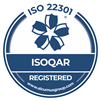How to optimise your checkout system and reduce abandon cart rate
You know the feeling - we have all been through it. You want to purchase an item and you know exactl
Online & Tech
Creating a website is a relatively easy thing to do. The internet is full of millions of different domain names, so the actual process of getting your own site created isn’t complex. But how do you make your website not only work but work well? This is where the real hard work comes into play. And whether your site is e-commerce or just there to showcase what you’re all about, it’s crucial that your site is user friendly.
This means making sure that your site is fully catered to (shock horror) the user. It's about having a site that is as easy to use as possible and that functions correctly. Ask yourself, if you were a potential customer using your site would you find it an easy experience where you are able to achieve what you want to? As with all things, there are a few key factors to bear in mind if you want to create a ‘killer website that your audience will love. What are they? You’re about to find out.
Fortunately, when we refer to navigation we aren’t referring to the seven seas - just your website. If your website is cluttered, with too many different options and menus galore, you're not thinking like a customer. A cluttered website with copious amounts of pages will leave your prospect confused, and this may well have a large bearing on metrics such as your bounce and exit rate in Google Analytics. In short, if you make it difficult for your audience to see what they need to see they won’t hang around for very long. Therefore, getting your navigation correct is vital in ensuring that your website is user friendly.
Make it simple to get from one part of your website to another. That means provide a search menu where people can enter in terms that will take them to a specific part of your site which matches their query. This also means making sure that every URL of your site works - nothing looks worse than having broken links emerging when someone wants to look at a particular page. Your site should be working across all formats - which leads directly onto the next point.
You’ve probably heard different statistics sprouted around of how mobile and tablet traffic has overtaken desktop traffic. It was widely publicised at the end of last year that mobile and tablet traffic accounted for over 51% of overall web browsing. That’s quite a shift that demonstrates how consumers searching habits have changed over the past decade. But despite these eye-opening metrics, many businesses have still not optimised their site specifically for mobile and tablet use.
Essentially many sites that you see on mobile come out with tiny text that require you to zoom in just to read the copy. You have probably encountered this before and we would hazard a guess that you found the whole process annoying. We doubt you stuck around for long let alone attempted any kind of purchase or intended action. So why would you want to make the same mistake with your site? Don’t. Instead optimise your site. Ensure that the site is easy to view on all formats.
It wouldn’t be a massive shock if the numbers mentioned last year were to increase even more in favour of mobile and tablet. Don’t be left behind - optimise.
It is remarkable how many businesses overload their site with copy which is packed with industry jargon which is often vague and unclear. It sometimes feels that people who write these sites, whilst being experts in their field, don’t know how to communicate with their audience. We cannot emphasise to you how important it is to get your language and tone correct. If you can refrain from, or at least reduce, your website of industry jargon you will be doing yourself and your business a massive favour.
Terms like stakeholder, paradigm, actionable, leverage and alignment might be relevant to you but will not be particularly interesting to people who are going to take the time to read your site. This is where you need to think like a customer. So, if you are going to write the copy or decide to hire an in-house writer, you need to make sure that the language is clear and to the point across your whole site.
It's quite astonishing to think how many customers abandon their purchase at the checkout section - the most crucial part of the site. At the start of the year, it was reported that there was a 69.89% average online shopping cart abandonment rate. Now whilst this might be explained by a degree of consumer indecisiveness and boredom, much of this may be explained by checkout systems which could be improved. So, if your website is e-commerce and allows prospects to buy from your site it is critical to get this part of your site right. This means getting up those logos. You know the ones verified by visa, McAfee Secure, Norton Secure. This creates trust with your customers, so they know that they can trust you with their financial information.
Why not give an indication of the progress cycle of the checkout page That way a customer will know where exactly they are on the page and in their case how much longer this will take to finish. Don’t create too many steps or your customer will switch to watch some Netflix faster than you can say checkout!
This is not a fun process for the customer, so it's important to remember that less really is more in this scenario. Another way to reduce chance of a high abandonment is by providing copious options for payment. Of course, this means accepting different cards (Mastercard, Visa etc.) but you should be mixing this up even more. Make sure to include quicker means of payment such as PayPal and Apple Pay which are much quicker and convenient for customers who are happy to pay quickly.
If you'd like to find out more about our integration options, check out our online payment solutions.

You know the feeling - we have all been through it. You want to purchase an item and you know exactl

One of the many challenges facing small businesses is how and where they sell or provide services to

We think that you have probably come across the acronym SEO before...
Post Office Limited T/A Payzone. Post Office Limited is registered in England and Wales. Registered Number 2154540. Registered Office: 100 Wood Street, London, EC2V 7ER. VAT registration number: GB172670502. Payzone site uses cookies. Some of these cookies are essential, while others help us to improve your experience by providing insights into how the site is being used. View our Cookie Policy and our Privacy Policy.




Cert No. 9819